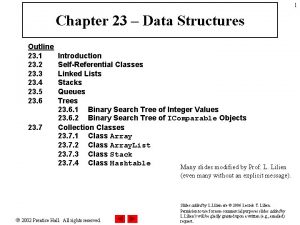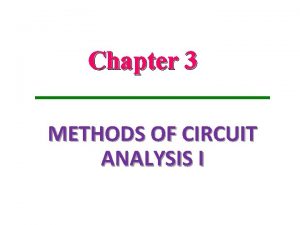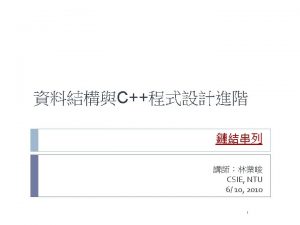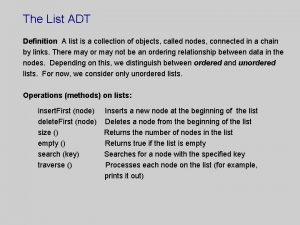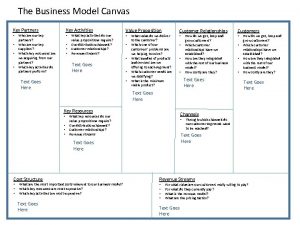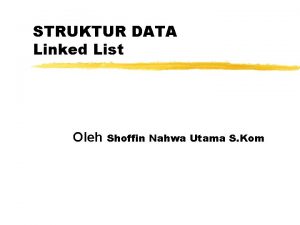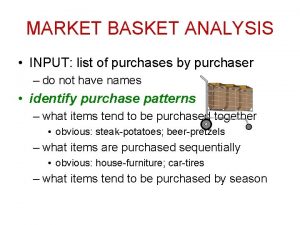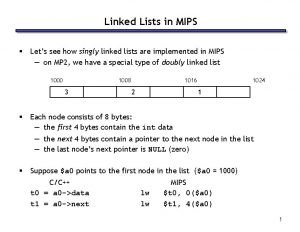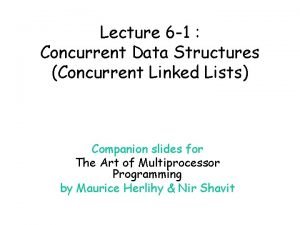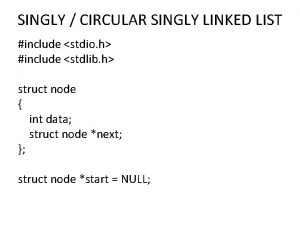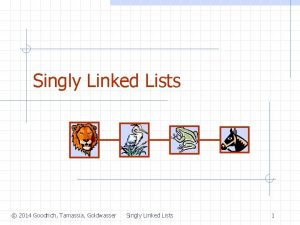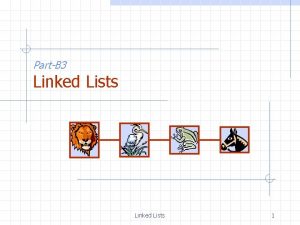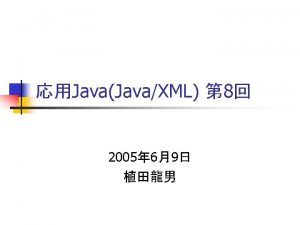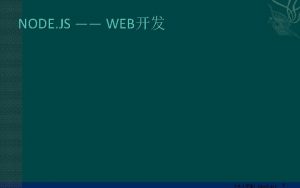Linked List 1 Singly Linked List Node key





![Singly Linked List • Array Implementation C E G J K key[ ] next[ Singly Linked List • Array Implementation C E G J K key[ ] next[](https://slidetodoc.com/presentation_image/5d10fb3ce6ad463923f3d6d368842e1a/image-6.jpg)



![Doubly Linked List • Array Implementation C E G J K P key[ ] Doubly Linked List • Array Implementation C E G J K P key[ ]](https://slidetodoc.com/presentation_image/5d10fb3ce6ad463923f3d6d368842e1a/image-10.jpg)



![Doubly Linked List • Implementation 1) Multiple Array key[ ], next[ ], prev[ ] Doubly Linked List • Implementation 1) Multiple Array key[ ], next[ ], prev[ ]](https://slidetodoc.com/presentation_image/5d10fb3ce6ad463923f3d6d368842e1a/image-14.jpg)


















![리스트 클래스 int _tmain(int argc, TCHAR* argv[ ], TCHAR* envp[ ]) { int n. 리스트 클래스 int _tmain(int argc, TCHAR* argv[ ], TCHAR* envp[ ]) { int n.](https://slidetodoc.com/presentation_image/5d10fb3ce6ad463923f3d6d368842e1a/image-33.jpg)

- Slides: 34

Linked List 1



Singly Linked List • 원소 (Node) 구성 key next pointer (1) Key field • 원소의 데이터 저장 (2) Pointer field • 다음 원소의 주소 저장 4

Singly Linked List • Data Member – L (list) : key fields + next pointer fields (next) – head[L] : list L 의 첫 원소의 주소 • List empty: head[L]= NIL • Last element: next[x] = NIL; head[L] / 5
![Singly Linked List Array Implementation C E G J K key next Singly Linked List • Array Implementation C E G J K key[ ] next[](https://slidetodoc.com/presentation_image/5d10fb3ce6ad463923f3d6d368842e1a/image-6.jpg)
Singly Linked List • Array Implementation C E G J K key[ ] next[ ] G 4 3 C 5 4 J 8 5 E 1 6 X NIL 8 K 9 9 P 6 1 P X 2 head[L]=3 7 10 6

Singly Linked List • Insert Operation – 주소 z 인 element 를 주소 x 의 element 다음에 삽입 x C E G (2) (1) z J K P X (1) next[z] = next[x] (2) next[x] = z F • Delete Operation – 주소 y 의 element 를 list에서 삭제 x C (1) E y G J K P X (1) next[x] = next[y] x 를 어떻게 찾나? ÞLIST-SEARCH ÞO(n) 7

Doubly Linked List • 원소 (Node) 구성 previous pointer key next pointer (1) Key field • 원소의 데이터 저장 (2) Next pointer field • 다음 원소의 주소 저장 (3) Previous pointer field • 직전 원소의 주소 저장 8

Doubly Linked List • Data Member – L (list) : key fields + next pointer fields (next) + previous pointer fields (prev) – head[L] : list L 의 첫 원소의 주소 • List empty: head[L]= NIL • Last element: next[x] = NIL • First element: prev[x] = NIL head[L] / 9
![Doubly Linked List Array Implementation C E G J K P key Doubly Linked List • Array Implementation C E G J K P key[ ]](https://slidetodoc.com/presentation_image/5d10fb3ce6ad463923f3d6d368842e1a/image-10.jpg)
Doubly Linked List • Array Implementation C E G J K P key[ ] next[ ] prev[ ] G 4 5 3 C 5 NIL 4 J 7 1 5 E 1 3 6 X NIL 9 8 K 9 4 9 P 6 8 1 X 2 head[L]=3 7 10 10

Doubly Linked List • LIST-INSERT( L, x) – list L 의 front 에 x 주소를 갖는 원소 삽입 – O(1) List non-empty 인 경우 (head[L] != NIL) (1) (2) (3) (4) head[L] (3) (4) (2) (1) x next[x] = head[L] prev[head[L]] = x head[L]=x prev[x]=NIL (2) List empty 인 경우 (head[L] = NIL) head[L] (3) (4) x (1) 11

Doubly Linked List • LIST-DELETE( L, x) – list L 의 x 주소에 있는 원소 삭제 – O(1) first element 가 아닌 경우 (1) next[prev[x]] = next[x] (2) prev[next[x]] = prev[x] x (2) first element 인 경우 (1) head[L] = next[x] (2) prev[next[x]] = prev[x] x (2) 12

Doubly Linked List • LIST-SEARCH(L, k) – list L 에서 key 값이 k 인 원소를 찾아, 그 주소 return – O(n) 13
![Doubly Linked List Implementation 1 Multiple Array key next prev Doubly Linked List • Implementation 1) Multiple Array key[ ], next[ ], prev[ ]](https://slidetodoc.com/presentation_image/5d10fb3ce6ad463923f3d6d368842e1a/image-14.jpg)
Doubly Linked List • Implementation 1) Multiple Array key[ ], next[ ], prev[ ] 3개의 array 사용 2) Single Array 하나의 array 사용 A[i] → key, A[i+1] → next, A[i+2] → prev 3) Node struct NODE{ int key; NODE* next; NODE* prev; }; NODE* head; 14

Rooted Tree Representation • Binary Tree – Left-child, right-child representation – Data member Node: key + parent pointer + left child pointer + right child pointer T: node 의 집합 Root[T]: root node 의 index 15

Rooted Tree Representation • 일반 Tree – Left-child, right-sibling representation – Data member Node: key + parent pointer + left child pointer + right sibling pointer T: node 의 집합 Root[T]: root node 의 index 16

Polynomials • Singly linked list 를 이용하여 다항식 표현 • 원소 (node) 구성 – Key field = coef (계수) + expo (지수) – Next pointer field = link (다음 항 연결) typedef struct Node { float coef; int expo; struct Node *link; }; 17

Polynomials • 표현 예 • A(x)=4 x 3+3 x 2+5 x • B(x)=3 x 4+x 3+2 x+1 ⇒ 효과적 메모리 사용 (cf) sequential list 18

Polynomials • Append. Term (PL, coef, expo, last) – 다항식의 항 1 개 (coef, expo) 를 추가하는 알고리즘 PL: list head last: list 마지막 노드의 주소 (ex) A(x)=4 x 3+3 x 2+5 x+2 19

Polynomials • Append Term 20





Polynomials • Addition Algorithm 25

Polynomials • Addition Results 26


리스트 클래스 • 비 템플릿 클래스 – afxcoll. h 헤더 파일 클래스 이름 데이터 타입 사용 예 COb. List CObject 포인터 COb. List list; CPtr. List void 포인터 CPtr. List list; CString. List list; 28


리스트 클래스 • 순환 // 리스트 제일 앞에서 출발하여 순환한다. POSITION pos = list. Get. Head. Position(); while(pos != NULL){ CString string = list. Get. Next(pos); cout << (LPCTSTR)string << endl; } cout << endl; // 리스트 제일 뒤에서 출발하여 순환한다. pos = list. Get. Tail. Position(); while(pos != NULL){ CString string = list. Get. Prev(pos); cout << (LPCTSTR)string << endl; } 30

리스트 클래스 • 항목 삽입과 삭제 // POSITION 타입의 변수 pos는 이전의 예제에서 선언한 것이다. pos = list. Find("포도"); list. Insert. Before(pos, "살구"); list. Insert. After(pos, "바나나"); list. Remove. At (pos); // 항목 삽입과 삭제 후 결과를 확인한다. pos = list. Get. Head. Position(); while(pos != NULL){ CString string = list. Get. Next(pos); cout << (LPCTSTR)string << endl; } 31

리스트 클래스 • 템플릿 리스트 클래스 #include "stdafx. h" #include "Console. h" #include <afxtempl. h> CWin. App the. App; using namespace std; struct Point 3 D { int x, y, z; Point 3 D() {} Point 3 D(int x 0, int y 0, int z 0) { x = x 0; y = y 0; z = z 0; } }; 32
![리스트 클래스 int tmainint argc TCHAR argv TCHAR envp int n 리스트 클래스 int _tmain(int argc, TCHAR* argv[ ], TCHAR* envp[ ]) { int n.](https://slidetodoc.com/presentation_image/5d10fb3ce6ad463923f3d6d368842e1a/image-33.jpg)
리스트 클래스 int _tmain(int argc, TCHAR* argv[ ], TCHAR* envp[ ]) { int n. Ret. Code = 0; if (!Afx. Win. Init(. . . )) { // 생략. . . } else { CList<Point 3 D, Point 3 D&> list; for(int i=0; i<5; i++) list. Add. Tail(Point 3 D(i, i*100)); POSITION pos = list. Get. Head. Position(); 33

리스트 클래스 } } while(pos != NULL) { Point 3 D pt = list. Get. Next(pos); cout << pt. x << ", " << pt. y << ", " << pt. z << endl; } return n. Ret. Code; 34
 Advantage of linked list
Advantage of linked list Singly vs doubly linked list
Singly vs doubly linked list Singly vs doubly linked list
Singly vs doubly linked list Algorithm for single linked list
Algorithm for single linked list Singly linked list in data structure
Singly linked list in data structure Polynomial addition using linked list in python
Polynomial addition using linked list in python Advantages and disadvantages of circular linked list
Advantages and disadvantages of circular linked list Singly linked list
Singly linked list Pengertian single linked list
Pengertian single linked list Circular linked list with header node
Circular linked list with header node Linked list remove first node
Linked list remove first node Reference node and non reference node
Reference node and non reference node Reference node and non reference node
Reference node and non reference node Constructive interference example
Constructive interference example Nodenext
Nodenext Hamiltonian operator
Hamiltonian operator Struct node int data struct node* next
Struct node int data struct node* next Singly reinforced beam
Singly reinforced beam Difference between singly and doubly reinforced beam
Difference between singly and doubly reinforced beam List adt definition
List adt definition List the components of node level simulator
List the components of node level simulator The business model canvas
The business model canvas Contoh bisnis model canvas makanan pdf
Contoh bisnis model canvas makanan pdf Generic linked list java
Generic linked list java Jenis linked list
Jenis linked list Tan is a lover of linked list
Tan is a lover of linked list Xor linked list c++
Xor linked list c++ Traverse a linked list c++
Traverse a linked list c++ Linked list in mips
Linked list in mips Linked list definition
Linked list definition Linked list diagram in java
Linked list diagram in java Language
Language Circular single linked list adalah
Circular single linked list adalah Concurrent linked list
Concurrent linked list Double linked list circular
Double linked list circular










